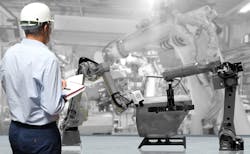Service Robots to Hit $30 Billion in Sales by 2022
According to data presented by BuyShares.co.uk, the entire market is expected to continue growing strongly and hit more than $30 billion in sales by 2022, a 30% increase in two years.
Americas Lead in the use of Service Robots
Recent years have witnessed a surge in the use of service robots, as they offer increased productivity and convenience in both professional and private settings. The entire market is divided into two main segments. Commercial robots are used to perform tasks in a business environment, like medical robots and automated guided vehicles used in warehouses.
Personal service robots include convenience robots, which perform tasks like cleaning and vacuuming, and entertainment robots, such as toys and photography drones.
In 2018, the entire market generated $13.7 billion in sales volume, revealed the Statista survey. This figure surged by almost 70% in the next two years, reaching $23.1 billion in 2020. The growing demand for service robots is expected to continue this year, with the sales value rising by another 17% year-over-year to $27bn. By the end of 2022, this figure is forecast to jump by another $3 billion.
Statistics show the service robotics market is led by the Americas, with an estimated sales value of $10.8 billion in 2021, up from $7.4 billion before the pandemic. This figure is forecast to jump to over $12 billion in 2022.
As the second-largest region, the Asia Pacific is expected to hit almost $7.4 billion in sales volume in 2021, a 20% jump in a year. The European market follows with a $7.3 billion value.
Medical Robots to Generate One-Third of Total Sales Value
Statistics show that most service robots are used in the medical industry and are expected to generate almost $9 billion or 33% of total sales value this year. In the next 12 months, this figure is set to jump to $10 billion. Technical innovations and demographic developments drive the market growth of these robots.
Robotic technologies can be more precise and flexible than human surgeons, making robot-assisted surgery a popular option. Since they are immune to infectious diseases, medical robots have also been implemented during the COVID-19 pandemic. They are also widely used in diagnostic, rehabilitation, and nursing care.
Statistics show the Americas dominate the medical robot's market. However, due to aging populations, the Asia-Pacific region is expected to witness the most significant growth in the future.
Convenience robots for domestic tasks ranked as the second-largest segment, with $6.7 billion in sales value in 2021. This figure is set to reach almost $7.5 billion next year. These robots are increasingly finding their way into households worldwide. Packed with different capabilities, they can make everyday life more comfortable. Statistics show the Asia-Pacific region is the leading market for convenience robots. However, the largest producer, iRobot, is headquartered in the United States.
As the fastest-growing segment of the commercial service robotics market, logistics is forecast to hit over $3.9 billion in sales volume this year, up from $3.1 billion in 2020. The pandemic fueled e-commerce surge continues driving demand for logistics robots, as they help automate and optimize operations, enabling higher precision, lower costs, and faster delivery times.
The Asia-Pacific region is forecast to witness the biggest increase in sales volume. However, Europe is expected to maintain its position as the region with the most sales of logistics service robots.
Statistics show the entire logistics robot industry is set to continue growing and reach $4.5 billion in sales by 2022.
To read the full article, visit https://buyshares.co.uk.
